Publications
2024
-
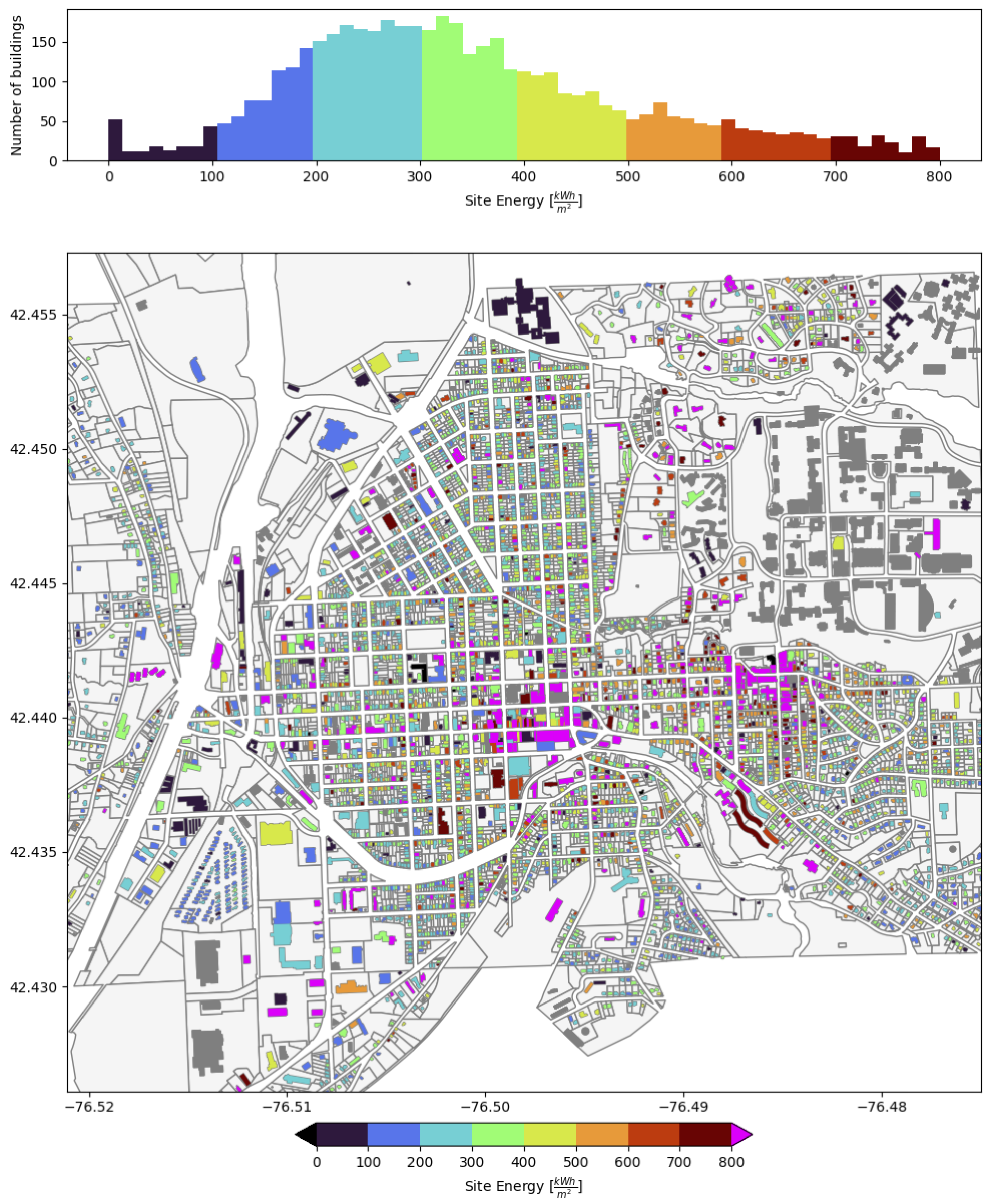 Towards auto-calibrated UBEM using readily available, underutilized urban data: A case study for Ithaca, NYKastner, Patrick, and Dogan, TimurEnergy and Buildings 2024
Towards auto-calibrated UBEM using readily available, underutilized urban data: A case study for Ithaca, NYKastner, Patrick, and Dogan, TimurEnergy and Buildings 2024@article{kastner2024towards, title = {Towards auto-calibrated UBEM using readily available, underutilized urban data: A case study for Ithaca, NY}, author = {Kastner, Patrick and Dogan, Timur}, journal = {Energy and Buildings}, pages = {114286}, year = {2024}, publisher = {Elsevier}, google_scholar_id = {4TOpqqG69KYC} }
2023
-
 A GAN-based Surrogate Model for Instantaneous Urban Wind Flow PredictionKastner, Patrick, and Dogan, TimurBuilding and Environment 2023
A GAN-based Surrogate Model for Instantaneous Urban Wind Flow PredictionKastner, Patrick, and Dogan, TimurBuilding and Environment 2023Urban form impacts the airflow patterns in cities and the resulting urban microclimate. This has significant implications for ventilation, overheating, wind chill, and safety concerns such as down drafts from skyscrapers. While Computational Fluid Dynamics (CFD) simulations are the best practice for analyzing urban airflow patterns in design, they are computationally expensive and require a high level of expertise, making them underutilized in the early design process. This paper presents a surrogate model for CFD using a Generative Adversarial Network (GAN) that can process arbitrary building geometries. The model is trained using an automated end-to-end pipeline based on Eddy3D and implemented within the Rhino and Grasshopper environment as an Open Neural Network Exchange (ONNX)-based CFD-GAN predictor. This workflow provides instantaneous simulation feedback within the design software, reduces the risk of user error, and allows for appropriate spatial resolution in early design. The CFD-GAN has demonstrated promising accuracy, with a Structural Similarity Index Measure (SSIM)4 range of 75%–97% on a limited training dataset of 564 unique urban geometries. Although the model currently has limitations regarding accuracy in complex urban wake regions, we show that these are likely not of concern for outdoor thermal comfort analyses. While it cannot replace CFD in later design stages, the CFD-GAN facilitates the incorporation of urban airflow analysis in early design with minimal effort and instantaneous performance feedback.
@article{kastner2023gan, title = {A GAN-based Surrogate Model for Instantaneous Urban Wind Flow Prediction}, author = {Kastner, Patrick and Dogan, Timur}, year = {2023}, journal = {Building and Environment}, publisher = {Elsevier}, pages = {110384}, google_scholar_id = {_kc_bZDykSQC}, }
2021
-
 Eddy3D: A toolkit for decoupled outdoor thermal comfort simulations in urban areasKastner, Patrick, and Dogan, TimurBuilding and Environment 2021
Eddy3D: A toolkit for decoupled outdoor thermal comfort simulations in urban areasKastner, Patrick, and Dogan, TimurBuilding and Environment 2021The architectural community needs holistic, evidence-based planning tools to promote urban resilience in the face of global warming. To ensure maximum impact, simulation-driven microclimate analysis methods must be integrated early in the design process. With Eddy3D, we present a toolkit to simulate outdoor thermal comfort (OTC) metrics with a decoupled approach. We motivate the decoupled systems framework with meteorological measurements and local and global sensitivity analyses of three different climates. For a real-world case study on a university campus, we present results for both wind velocity and mean radiant temperature simulations. Finally, we discuss the advantages and disadvantages of a decoupled simulation approach considering design aiding and the architectural community. Our findings support reduced simulation time and flexibility, with the caveat of reduced accuracy due to neglecting forced convection, albeit this being less relevant in the early stages of design. The framework presented in this manuscript has been implemented and released as Eddy3D, a plugin for Rhino & Grasshopper.
@article{Kastner2021eddy3d, title = {Eddy3D: A toolkit for decoupled outdoor thermal comfort simulations in urban areas}, author = {Kastner, Patrick and Dogan, Timur}, year = {2021}, journal = {Building and Environment}, pages = {108639}, doi = {https://doi.org/10.1016/j.buildenv.2021.108639}, issn = {0360-1323}, keywords = {Case study, Design, Outdoor environment, Thermal comfort, Solar, Wind}, google_scholar_id = {Se3iqnhoufwC}, } -
 Modeling Outdoor Thermal Comfort along Cycling Routes at Varying Levels of Physical Accuracy to Predict Bike Ridership in Cambridge, MABuilding and Environment 2021
Modeling Outdoor Thermal Comfort along Cycling Routes at Varying Levels of Physical Accuracy to Predict Bike Ridership in Cambridge, MABuilding and Environment 2021The Universal Thermal Climate Index (UTCI) has been linked to outdoor activity patterns and used to evaluate the effectiveness of urban interventions to improve thermal comfort. This study investigates how simulating the urban environment at increasing levels of physical accuracy impacts UTCI values along three cycling routes in Cambridge, Massachusetts. Baseline UTCI values are estimated using a local weather file, and the following increments in physical accuracy are considered: wind-scaling, shading from buildings, shading and cooling from trees, computational fluid dynamics simulations for wind speeds, and simulated surface temperatures. With bike ridership data from Bluebikes, Boston’s bike-sharing program, the relationship between bike ridership patterns and UTCI values along each route is studied. Supervised machine learning models are applied to predict bike ridership based on UTCI and other predictors. UTCI simulation results show that incorporating the various increments of accuracy influences hourly UTCI values at urban areas and exposed areas differently. Incorporating local wind speeds is especially impactful for urban areas. The statistical models trained to predict hourly bike trip counts based on UTCI and other demand and weather predictors achieved a root-mean-squared error of 1.06 trips. 47% of predictions were correct, and an additional 42% of predictions were off by 1 trip. This study demonstrates the importance of spatial refinement in simulating UTCI, and motivates future research into efficient simulation methods or rules-of-thumb for deriving spatial-temporal UTCI values. Future work into building a robust predictive model would motivate the design of thermally comfortable environments for human-powered transportation in cities.
@article{young2021modeling, title = {Modeling Outdoor Thermal Comfort along Cycling Routes at Varying Levels of Physical Accuracy to Predict Bike Ridership in Cambridge, MA}, author = {Young, Elizabeth and Kastner, Patrick and Dogan, Timur and Chokhachian, Ata and Mokhtar, Sarah and Reinhart, Christoph}, year = {2021}, journal = {Building and Environment}, publisher = {Elsevier}, pages = {108577}, google_scholar_id = {roLk4NBRz8UC} } -
 Towards Safer Work Environments During the COVID-19 Crisis: A Study Of Different Floor Plan Layouts and Ventilation Strategies Coupling OpenFOAM and Airborne Pathogen Data for Actionable, Simulation-based Feedback in DesignDe Simone, Zoe, Kastner, Patrick, and Dogan, TimurIn Building Simulation Conference Proceedings 2021
Towards Safer Work Environments During the COVID-19 Crisis: A Study Of Different Floor Plan Layouts and Ventilation Strategies Coupling OpenFOAM and Airborne Pathogen Data for Actionable, Simulation-based Feedback in DesignDe Simone, Zoe, Kastner, Patrick, and Dogan, TimurIn Building Simulation Conference Proceedings 2021As work environments struggle to reopen during the current COVID-19 pandemic, it is crucial to establish practical decision-aiding tools. While a strong emphasis has been placed on determining generic guidelines to reduce the risk of airborne viral spread, there is a lack of free and easy-to-use simulation workflows to quantify indoor air quality and the risk of airborne pathogens indoors at a spatial resolution that can take into account floor-plan layouts, furniture, and ventilation inlet-outlet positions. This paper describes the development of a new, free, early design tool that allows designers and other stakeholders to simulate and compare viral airborne concentration under different indoor conditions. The tool leverages OpenFOAM-based Computational Fluid Dynamics (CFD) and a passive scalar simulation approach to allow architects and interior designers to quantify airborne pathogens’ exposure. The tool is integrated into the popular Rhino3d & Grasshopper CAD environment to facilitate its application in fast-paced design processes. We demonstrate good agreement compared to a CFD benchmark test. Further, we validate newly developed COVID-19 capabilities by comparing our results to an existing restaurant case study that included tracer gas measurements and validation using Fluent (Ansys). We demonstrate applications of the tool in a comparative study of a restaurant that investigates how plan and furniture layout interventions, ventilation strategies can impact the movement of airborne pathogens in indoor environments.
@inproceedings{DeSimone2021, title = {Towards Safer Work Environments During the COVID-19 Crisis: A Study Of Different Floor Plan Layouts and Ventilation Strategies Coupling OpenFOAM and Airborne Pathogen Data for Actionable, Simulation-based Feedback in Design}, author = {{De Simone}, Zoe and Kastner, Patrick and Dogan, Timur}, year = {2021}, booktitle = {Building Simulation Conference Proceedings}, google_scholar_id = {LkGwnXOMwfcC}, } -
 Surfer: A Fast Simulation Algorithm to Predict Surface Temperatures and Mean Radiant Temperatures in Large Urban ModelsDogan, Timur, Kastner, Patrick, and Mermelstein, RemyBuilding and Environment 2021
Surfer: A Fast Simulation Algorithm to Predict Surface Temperatures and Mean Radiant Temperatures in Large Urban ModelsDogan, Timur, Kastner, Patrick, and Mermelstein, RemyBuilding and Environment 2021Outdoor thermal comfort simulation simulations rely on the mean radiant temperature (MRT) seen by pedestrians as an important input that remains difficult to compute. Especially for large urban models, computing relevant surface temperatures and radiation fluxes that make up the MRT is a daunting task in terms of simulation setup and the computational overhead. We propose a new algorithm to estimate exterior surface temperatures of building facades, roofs, and ground surfaces in an arbitrary urban 3D model. The algorithm discretizes all model surfaces and clusters them by material properties and sky and sun exposure to reduce computational complexity. The model setup is fully automated, and the algorithm is implemented in the popular Rhino3d CAD environment. We demonstrate the accuracy of the algorithm by comparing both the resulting external surface temperatures against a high-fidelity simulation and the final MRT against real-world measurements. We report an RMSE of 1.8\degC and 2.0\degC, respectively, while reducing simulation times by a factor of 80. Envisioned applications of the algorithm range from rapid microclimate simulations in fast-paced urban design processes to large scale urban comfort evaluation of existing cities.
@article{DOGAN2021surfer, title = {Surfer: A Fast Simulation Algorithm to Predict Surface Temperatures and Mean Radiant Temperatures in Large Urban Models}, author = {Dogan, Timur and Kastner, Patrick and Mermelstein, Remy}, year = {2021}, journal = {Building and Environment}, pages = {107762}, doi = {https://doi.org/10.1016/j.buildenv.2021.107762}, issn = {0360-1323}, url = {https://www.researchgate.net/publication/350385969_Surfer_A_fast_simulation_algorithm_to_predict_surface_temperatures_and_mean_radiant_temperatures_in_large_urban_models}, keywords = {Comfort, Surface-temperature, Mean-radiant-temperature, Urban, Design, Microclimate}, google_scholar_id = {eQOLeE2rZwMC}, }
2020
-
 Predicting Space Usage by Multi-Objective Assessment of Outdoor Thermal Comfort around a University CampusKastner, Patrick, and Dogan, TimurIn SimAUD 2020 Proceedings 2020
Predicting Space Usage by Multi-Objective Assessment of Outdoor Thermal Comfort around a University CampusKastner, Patrick, and Dogan, TimurIn SimAUD 2020 Proceedings 2020With the impending issues regarding global warming, urban design is considered a key driver to improve the microclimate in cities. For public spaces, studies suggest that outdoor thermal comfort may be seen as a proxy for space usage, and in turn, its attractiveness to people. Although the topic has gained interest in recent years, the discussion so far has focused on computing the metrics rather than deriving interventions from them. Here, we use the tool Eddy3D to model and analyze the outdoor thermal comfort of a designated area around a university campus. Further, we demonstrate how to estimate space usage from those results. Finally, we conduct a spatial sensitivity analysis of the underlying results as a step towards decision aiding. Our work demonstrates how decision-makers may derive areas where interventions will likely have the largest impact on outdoor thermal comfort performance.
@inproceedings{kastner2020predicting, title = {Predicting Space Usage by Multi-Objective Assessment of Outdoor Thermal Comfort around a University Campus}, author = {Kastner, Patrick and Dogan, Timur}, year = {2020}, booktitle = {SimAUD 2020 Proceedings}, pages = {85--91}, google_scholar_id = {2osOgNQ5qMEC}, } -
 Solving Thermal Bridging Problems for Architectural Applications with OpenFOAMKastner, Patrick, and Dogan, TimurIn SimAUD 2020 Proceedings 2020
Solving Thermal Bridging Problems for Architectural Applications with OpenFOAMKastner, Patrick, and Dogan, TimurIn SimAUD 2020 Proceedings 2020Although recent advancements in computational architecture show promising capabilities, it remains difficult for architects to conduct advanced simulations due to the limited software interoperability. For thermal bridging analyses, the architectural community traditionally relies on specific software tools that are not integrated into a CAD environment. To integrate such analyses into the ongoing design process, we implement a software tool to run heat transfer simulations with OpenFOAM from Grasshopper and Rhinoceros. This paper presents an implementation for box-shaped geometries and compares its results to a thermal bridge analysis from a validated simulation engine. We show that OpenFOAM’s chtMultiregionFoam solver is capable of accurately predicting temperature distributions in a geometry setup with 13 different regions and 8 different materials. In conclusion, we show that heat transfer studies can be highly automated and integrated into an iterative design process.
@inproceedings{kastner2020solving, title = {Solving Thermal Bridging Problems for Architectural Applications with OpenFOAM}, author = {Kastner, Patrick and Dogan, Timur}, year = {2020}, booktitle = {SimAUD 2020 Proceedings}, pages = {405--412}, google_scholar_id = {qjMakFHDy7sC}, } -
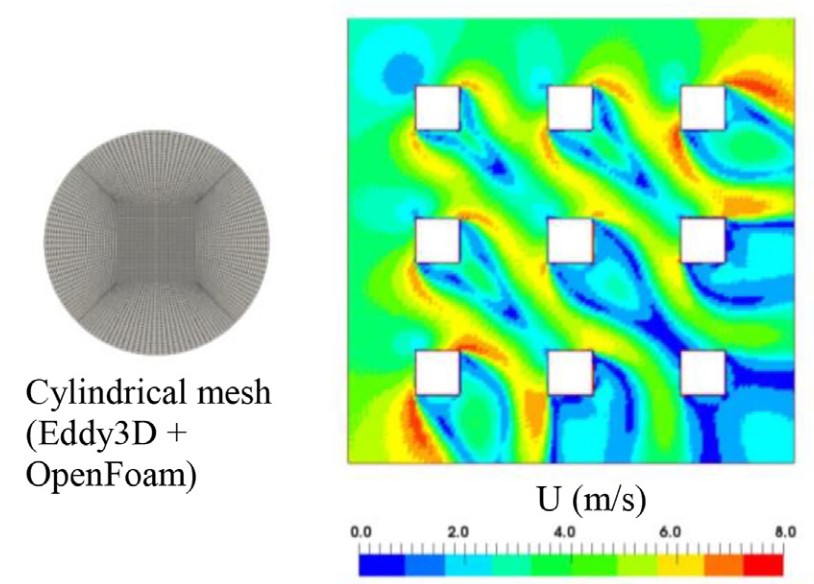 From Energy Performative to Livable Mediterranean Cities: An Annual Outdoor Thermal Comfort and Energy Balance Cross-climatic Typological StudyJournal of Energy and Buildings 2020
From Energy Performative to Livable Mediterranean Cities: An Annual Outdoor Thermal Comfort and Energy Balance Cross-climatic Typological StudyJournal of Energy and Buildings 2020With the rise of awareness of health and well-being in cities, urban environmental analysis should expand from energy performance to new environmental quality-based considerations. The limited potential to annually evaluate outdoor thermal comfort, predominant among these considerations, has restricted the exploration of the interrelations between urban morphology and annual energy performance. This study aims to bridge this gap by capitalizing on the new capabilities of Eddy3D – a Grasshopper plugin which enables effective calculations of hourly microclimatic wind factors via OpenFOAM which in turn are used to generate annual outdoor thermal comfort plots. Using this method, a parametric study was conducted for different typology and density scenarios in three different hot climatic contexts in Israel. The automated analytical workflow evaluated a total of 60 design iterations for their energy balance, outdoor thermal comfort autonomy (OTCA) and self-shading levels using the shade index. The high correlation found here between the annual shade index and the OTCA, across all climatic contexts, shows the potential of the shade index to serve as an effective indicator, in these contexts, for comparative or optimization outdoor comfort studies. Further results are both the superiority of the courtyard typology in both energy and outdoor comfort studies, and the contrasting impact of higher density on the annual energy balance (lower performance) and outdoor thermal comfort (higher performance) in hot climates. The annual plots of both the energy balance and OTCA reveal various seasonal and monthly trends in the three different climatic zones which can lead to localized and seasonal urban design strategies.
@article{natanian2020energy, title = {From Energy Performative to Livable Mediterranean Cities: An Annual Outdoor Thermal Comfort and Energy Balance Cross-climatic Typological Study}, author = {Natanian, Jonathan and Kastner, Patrick and Dogan, Timur and Auer, Thomas}, year = {2020}, journal = {Journal of Energy and Buildings}, publisher = {Elsevier}, volume = {224}, pages = {110283}, doi = {10.1016/j.enbuild.2020.110283}, google_scholar_id = {UeHWp8X0CEIC}, } -
 Streamlined CFD Simulation Framework to Generate Wind-pressure Coefficients on Building Facades for Airflow Network SimulationsDogan, Timur, and Kastner, PatrickJournal of Building Simulation 2020
Streamlined CFD Simulation Framework to Generate Wind-pressure Coefficients on Building Facades for Airflow Network SimulationsDogan, Timur, and Kastner, PatrickJournal of Building Simulation 2020Building energy modeling software generally comes with capable airflow network solvers for natural ventilation evaluation in multi-zone building energy models. These approaches rely on pressure coefficient arrays representing different wind directions derived from simple box-shaped buildings without contextual obstructions. For urban or obstructed sites and more complex building shapes, however, further evaluation is needed to avoid geometric oversimplification. In this study, we present an automated and easy-to-use simulation workflow for OpenFOAM-based exterior airflow simulations to generate pressure coefficient arrays for arbitrary building shapes and contextual situations. The workflow is compared to other methods commonly used to obtain pressure coefficients for natural ventilation analysis. Finally, we assess for which climate zones and building types modelers should rely on more accurate CFD-based pressure coefficients and where it may be justifiable to rely on easier and readily available analytical approaches to determine pressure coefficients. Results suggest that existing workflows lead to significant error in predicted comfort hours for climates in the global South and modelers should consider CFD based façade pressure coefficient.
@article{dogan2020streamlined, title = {Streamlined CFD Simulation Framework to Generate Wind-pressure Coefficients on Building Facades for Airflow Network Simulations}, author = {Dogan, Timur and Kastner, Patrick}, year = {2020}, journal = {Journal of Building Simulation}, publisher = {Tsinghua University Press}, pages = {1--12}, doi = {10.1007/s12273-020-0727-x}, video = {https://vimeo.com/375755963}, google_scholar_id = {WF5omc3nYNoC}, }
2019
-
 A Cylindrical Meshing Methodology for Annual Urban Computational Fluid Dynamics SimulationsKastner, Patrick, and Dogan, TimurJournal of Building Performance Simulation 2019
A Cylindrical Meshing Methodology for Annual Urban Computational Fluid Dynamics SimulationsKastner, Patrick, and Dogan, TimurJournal of Building Performance Simulation 2019For urban CFD simulations, it is considered a best practice to use a box-shaped simulation domain. Box-shaped domains, however, show drawbacks for airflow from several wind directions as remeshing and additional preprocessing steps become necessary. We introduce a routine to create a cylindrical mesh that expedites the simulation of arbitrary wind directions using OpenFOAM. Results computed with the cylindrical domain are validated against wind tunnel data. We report that the cylindrical method yields comparable results in terms of accuracy and convergence behaviour. Further, run time comparisons in a real-world scenario are conducted to discuss its advantages and limitations. Based on the findings, we recommend using the cylindrical approach if at least eight wind directions are analyzed for which we report 18% run time savings. The cylindrical domain along with automated best practice boundary conditions has been implemented in Eddy3D –– a plugin for Rhinoceros.
@article{kastner2019cylindrical, title = {A Cylindrical Meshing Methodology for Annual Urban Computational Fluid Dynamics Simulations}, author = {Kastner, Patrick and Dogan, Timur}, year = {2019}, journal = {Journal of Building Performance Simulation}, publisher = {Taylor \& Francis}, volume = {13}, number = {1}, pages = {59--68}, doi = {10.1080/19401493.2019.1692906}, video = {https://vimeo.com/375755947}, google_scholar_id = {d1gkVwhDpl0C}, } -
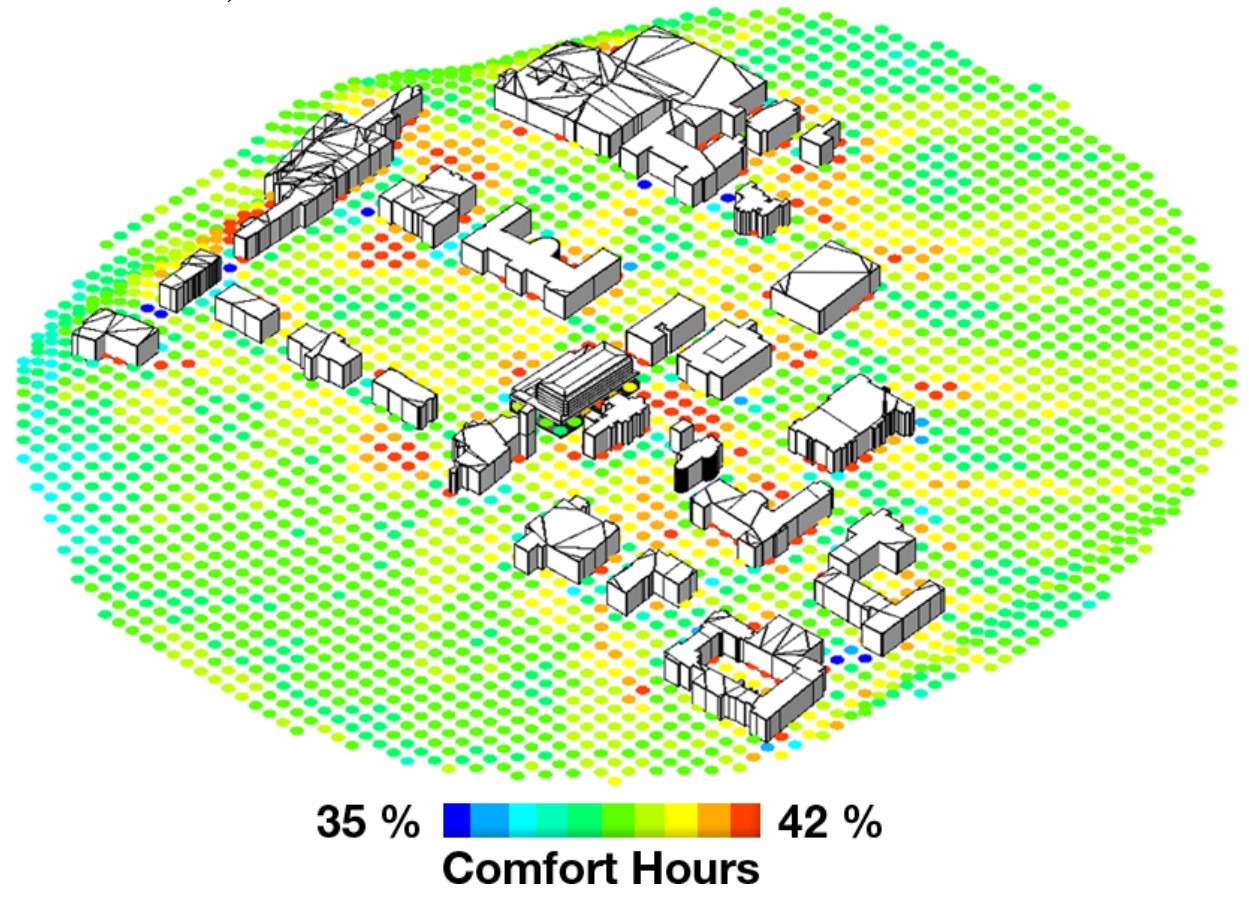 Towards High-Resolution Annual Outdoor Thermal Comfort Mapping In Urban DesignKastner, Patrick, and Dogan, TimurIn Building Simulation Conference Proceedings 2019
Towards High-Resolution Annual Outdoor Thermal Comfort Mapping In Urban DesignKastner, Patrick, and Dogan, TimurIn Building Simulation Conference Proceedings 2019Global warming and increasingly dense cities lead to poor outdoor thermal comfort that may not only be detrimental to our health and well-being but also decreases social and commercial activities. Although workflows for the analysis of thermal comfort exist, they have yet transitioned into the quotidian architectural design process. Our work-flow allows for annual outdoor comfort analyses that are seamlessly integrated into a commonly-used CAD environment. We simulated the annual outdoor thermal comfort on a university campus and discuss which simplifications seem appropriate by means of preliminary on-site measurements. The results exemplify the possibility to conduct such analyses within reasonable time and accuracy if some simplifications to the UTCI estimation are acceptable.
@inproceedings{kastner2019towards, title = {Towards High-Resolution Annual Outdoor Thermal Comfort Mapping In Urban Design}, author = {Kastner, Patrick and Dogan, Timur}, year = {2019}, booktitle = {Building Simulation Conference Proceedings}, google_scholar_id = {LkGwnXOMwfcC}, }
2018
-
 Streamlining Meshing Methodologies for Annual Urban CFD SimulationsKastner, Patrick, and Dogan, TimurIn IBPSA: eSIM Conference Proceedings 2018
Streamlining Meshing Methodologies for Annual Urban CFD SimulationsKastner, Patrick, and Dogan, TimurIn IBPSA: eSIM Conference Proceedings 2018For environmental CFD simulations, it is considered best practice to use a box-shaped wind tunnel as simulation domain. A box-shaped wind tunnel, however, shows drawbacks when it comes to simulating air flow from several wind directions-remeshing and additional preprocessing steps may be necessary and can be considerable time constraints. We utilize a routine implemented in Grasshopper to create a cylindrical computational mesh that allows for the simulation of arbitrary wind directions in a streamlined manner with the open source software OpenFOAM. We estimate the time savings that are possible along with specific mesh properties to take advantage of the proposed method. For validation purposes, commonly used wind tunnel data are presented. A proof of concept tool is implemented in the Rhinoceros CAD modeling environment and will be released publicly.
@inproceedings{kastner2018streamlining, title = {Streamlining Meshing Methodologies for Annual Urban CFD Simulations}, author = {Kastner, Patrick and Dogan, Timur}, year = {2018}, booktitle = {IBPSA: eSIM Conference Proceedings}, google_scholar_id = {u5HHmVD_uO8C}, } -
 Streamlined CFD Simulation Framework to Generate Wind-Pressure Coefficients on Building Facades for Airflow Network SimulationsDogan, Timur, and Kastner, PatrickIn IBPC: 7th International Building Physics Conference Proceedings 2018
Streamlined CFD Simulation Framework to Generate Wind-Pressure Coefficients on Building Facades for Airflow Network SimulationsDogan, Timur, and Kastner, PatrickIn IBPC: 7th International Building Physics Conference Proceedings 2018Energy modeling packages such as EnergyPlus and TRNSYS come with capable airflow network solvers for natural ventilation evaluation in multi-zone building energy models. These approaches rely on pressure coefficient arrays of different wind directions based on simple box-shaped buildings without contextual obstructions. For specific sites, however, further attention is needed to avoid geometric oversimplification. In this study, we present an automated and easy-to-use simulation workflow for exterior airflow simulation based on OpenFOAM to generate pressure coefficient arrays for arbitrary building shapes and contextual situations. The workflow is compared to other methods commonly used to obtain pressure coefficients for natural ventilation simulation.
@inproceedings{dogan2018streamlined, title = {Streamlined CFD Simulation Framework to Generate Wind-Pressure Coefficients on Building Facades for Airflow Network Simulations}, author = {Dogan, Timur and Kastner, Patrick}, year = {2018}, booktitle = {IBPC: 7th International Building Physics Conference Proceedings}, doi = {10.14305/ibpc.2018.ms-5.05}, google_scholar_id = {kNdYIx-mwKoC}, } -
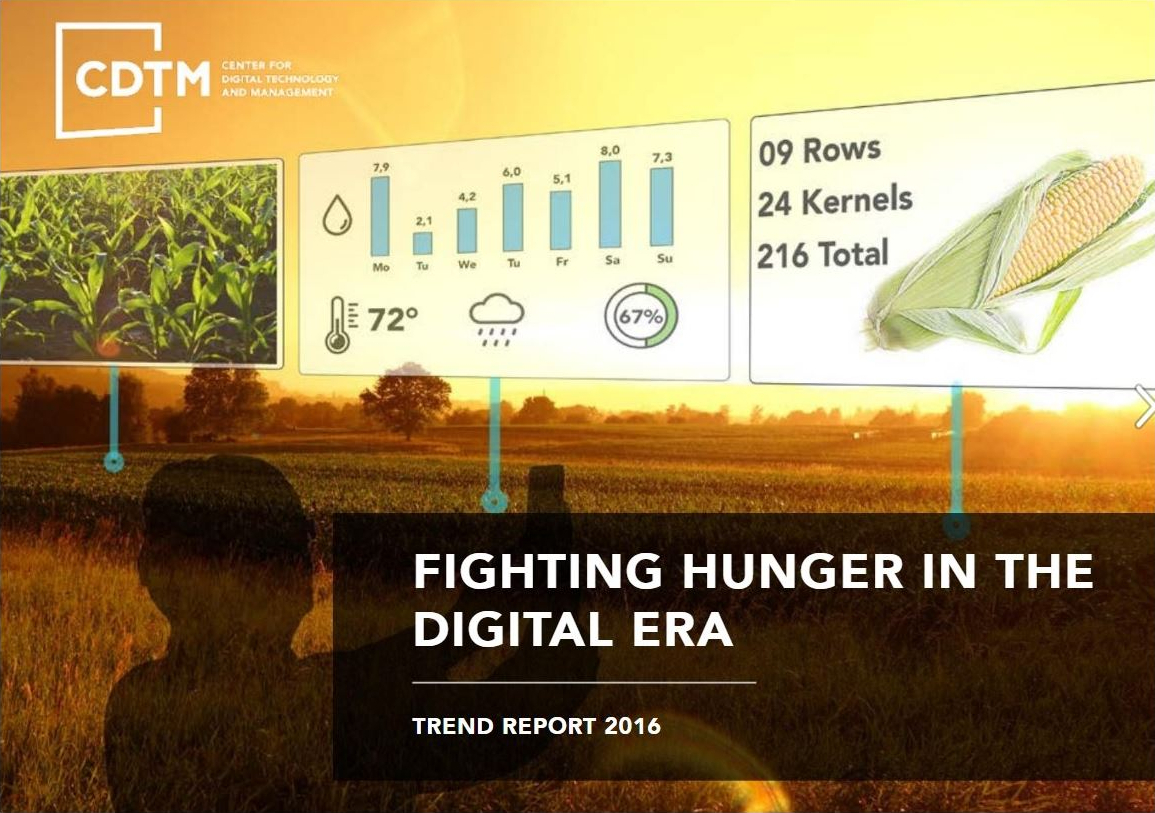 Fighting Hunger in the Digital EraAltenmüller, Laurenz, Borrmann, Kim, Braun, Philip and 25 more authorsCenter for Digital Technology and Management (CDTM) 2018
Fighting Hunger in the Digital EraAltenmüller, Laurenz, Borrmann, Kim, Braun, Philip and 25 more authorsCenter for Digital Technology and Management (CDTM) 2018This report is the result of the Trend Seminar course, which is part of the interdisciplinary add-on study program in Technology Management at CDTM. About 25 selected students of various disciplines, such as Business Administration, Economics, Psychology, Computer Science, Electrical Engineering, and more work together on a relevant topic related to ICT. Over seven intense weeks of fulltime work, the participating students dive deeply into the topic of the Trend Seminar. Working in several interdisciplinary subteams, students apply the knowledge from their main studies and learn new perspectives from their team members. They conduct trend research, develop scenarios of the future, generate ideas for innovative products or services and detail them out to concrete business concepts.
@article{altenmuller2018fighting, title = {Fighting Hunger in the Digital Era}, author = {Altenm{\"u}ller, Laurenz and Borrmann, Kim and Braun, Philip and Chen, Yingxi and D{\"u}mmling, Tobias and Feuerbacher, Christian and Fr{\"o}hlich, Michael and Gebauer, Jakob and Gebhardt, Christian and Hahn, David and Hesse, Adrian and Hülsemeyer, Christian and Juras, Peter and Kastner, Patrick and Kühl, Josephine and Marquardt, Janis and O'Donnell, MaryClare and Padmakumara, Lakmal and Patz, Martin and Cardona, FerranPla and Rambold, Lukas and Schmidtchen, Hagen and Secules, Chiara and Stanggassinger, Johannes and Wessling, Sophia and Wiggert, Marius and Bechthold, Laura and Lachner, Florian}, year = {2018}, journal = {Center for Digital Technology and Management (CDTM)}, booktitle = {Fighting Hunger in the Digital Era}, publisher = {Center for Digital Technology and Management}, number = {CDTM Trend Report 2016}, google_scholar_id = {Tyk-4Ss8FVUC}, }
Theses
2022
-
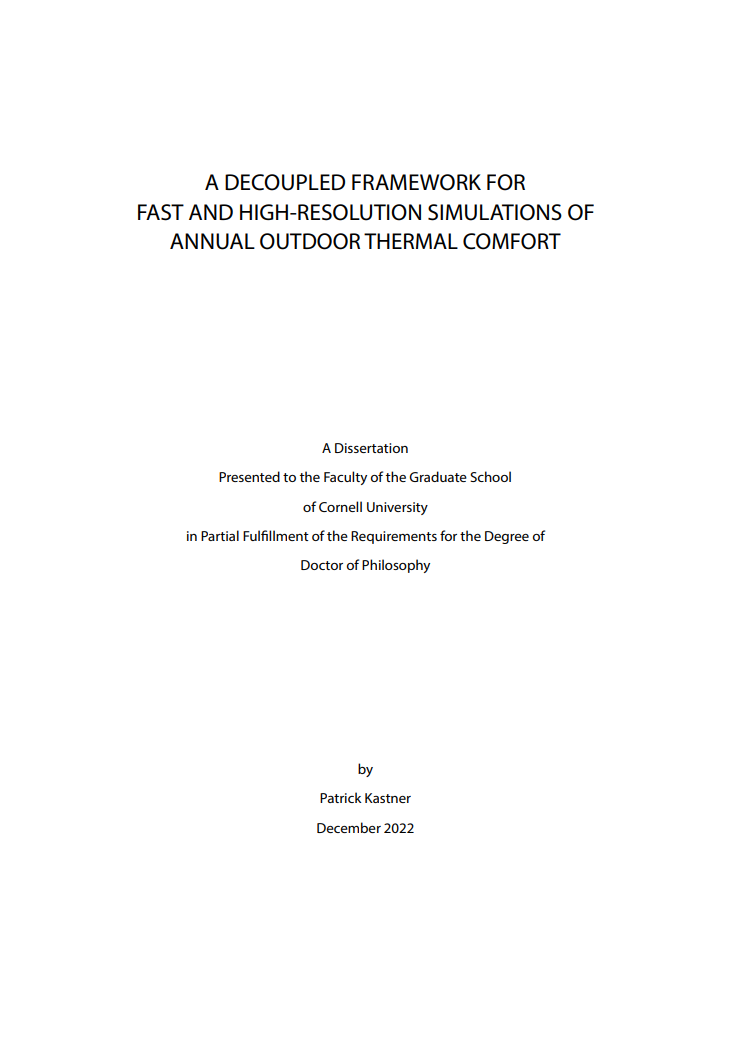 A Decoupled Framework for Fast and High-Resolution Simulations of Annual Outdoor Thermal ComfortKastner, PatrickPh.D. Thesis — Cornell University 2022
A Decoupled Framework for Fast and High-Resolution Simulations of Annual Outdoor Thermal ComfortKastner, PatrickPh.D. Thesis — Cornell University 2022Cities will be exposed to a substantial increase in extreme weather events as global warming continues, thereby affecting the microclimate they create for their citizens. The microclimate in cities is shaped by the built environment, proposed and developed by architects and urban designers, and constrained by the zoning rules imposed by urban planners. These stakeholders go through a design process where the most impactful changes can only be made very early on; however, for those specific stakeholders, there are currently no computational tools to estimate the microclimatic impact of their designs at this crucial stage in early design. This thesis introduces a decoupled approach to simulating outdoor thermal comfort, motivated by global sensitivity analyses. For this, computational fluid dynamics and ray tracing processes are streamlined and validated, which are required to simulate the wind velocity and mean radiant temperature in urban areas. Further, a surrogate model driven by a generative adversarial network is introduced, demonstrating near-instantaneous performance feedback in very early design. In three case studies, the contributions are used in practice to (1) engage in building-scale architectural design, (2) run parametric studies and optimization for urban design, and (3) inform city-scale urban policy. In conclusion, the latest machine learning techniques and the opportunities they provide will revolutionize the way we engage with environmental performance simulation in the urban design process.
@article{kastner2022decoupled, title = {A Decoupled Framework for Fast and High-Resolution Simulations of Annual Outdoor Thermal Comfort}, author = {Kastner, Patrick}, year = {2022}, journal = {Ph.D. Thesis --- Cornell University}, google_scholar_id = {YOwf2qJgpHMC}, }
2016
-
 Customizing OpenFOAM to Assess Wind-induced Natural Ventilation of Classrooms: A Case Study for BRAC UniversityKastner, PatrickM.S. Thesis — Technical University of Munich (TUM) 2016
Customizing OpenFOAM to Assess Wind-induced Natural Ventilation of Classrooms: A Case Study for BRAC UniversityKastner, PatrickM.S. Thesis — Technical University of Munich (TUM) 2016With increased awareness of sustainability, natural ventilation has become a strategy to reduce energy consumption in the built environment while providing comfortable indoor air quality. Themain aim of this thesis was to apply the CFD software OpenFOAM, to investigate the wind-induced natural ventilation potential of classrooms. Relevant ventilation metrics such as air change rates, age of air, and CO2 concentrationswere implemented. External and internal wind flows were simulated in one domain to assess the natural ventilation potential via RANS turbulence modeling. A case setup for a simple cross-ventilation geometry was validated against wind tunnel measurements in accordance with CFD guidelines for the built environment. Based on the validation, a case study was conducted for BRAC University—located in subtropical Asia. The validation study revealed that OpenFOAM was able to accurately predict the flow field and flow rates for the cross-ventilation geometry. Further, OpenFOAM’s passive scalar transport method is able to predict CO2 concentrations with a reasonable error range, while the work-flow can be highly automated. Applying these results to the case study, we suggest a number of geometry modifications to optimize the natural ventilation potential of classrooms for BRAC University. These include specific placement based on the wind direction, and either relocation or shape optimization of adjacent staircases. Additionally, we suggest the use of operable windows to accommodate temporal fluctuations throughout the year. Finally, passive scalar transport methods, which derive metrics like the age of air or CO2 concentrations, provide additional valuable information that should not be overlooked when evaluating design principles. In the future, it may be possible to employ tools based on the implemented ventilation metrics to automate the search for optimized building geometries for maximizing the natural ventilation potential.
@article{kastner2016customizing, title = {Customizing OpenFOAM to Assess Wind-induced Natural Ventilation of Classrooms: A Case Study for BRAC University}, author = {Kastner, Patrick}, year = {2016}, journal = {M.S. Thesis --- Technical University of Munich (TUM)}, google_scholar_id = {hqOjcs7Dif8C}, }
2012
-
 Strukturelle und elektrische Charakterisierung von multikristallinem String-Ribbon Silizium für die PhotovoltaikKastner, PatrickB.S. Thesis — University of Erlangen-Nuremberg (FAU) 2012
Strukturelle und elektrische Charakterisierung von multikristallinem String-Ribbon Silizium für die PhotovoltaikKastner, PatrickB.S. Thesis — University of Erlangen-Nuremberg (FAU) 2012In the last decades the String-Ribbon technique has been shown as an alternative process to produce multicristalline silicon wafers for the photovoltaic industry. Different researches showed that one can affect and control the wafer quality by varying the process parameters. In this work, four ribbon wafers with obvious structural differences were analysed in terms of their electrical and structural specifics. Two of the four wafers were reference samples, which were produced with common growth parameters. In addition, one wafer with significant large grains was investigated. The last ribbon apparently showed extensive twin regions in the boundary areas. The ribbons were analysed in terms of etch pit density, minority charge carrier lifetime, grain orientation, solid/liquid interface and local thickness variations.
@article{kastner2012strukturelle, title = {Strukturelle und elektrische Charakterisierung von multikristallinem String-Ribbon Silizium f{\"u}r die Photovoltaik}, author = {Kastner, Patrick}, year = {2012}, journal = {B.S. Thesis --- University of Erlangen-Nuremberg (FAU)}, doi = {10.13140/rg.2.2.26080.81920}, }










